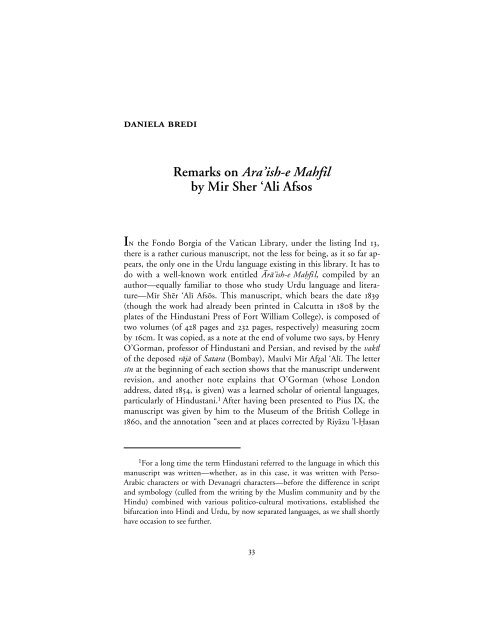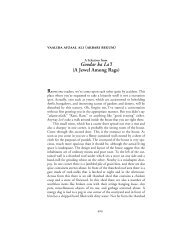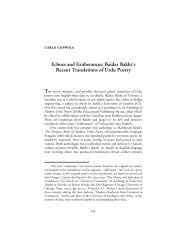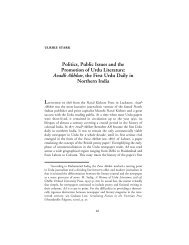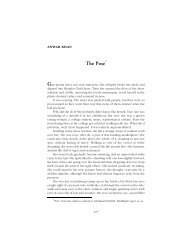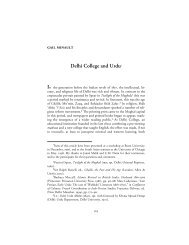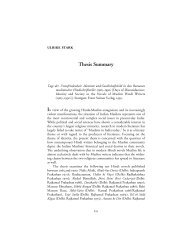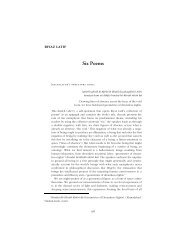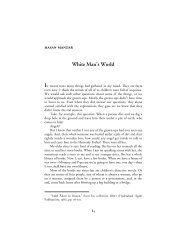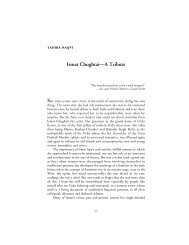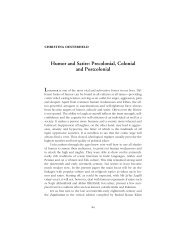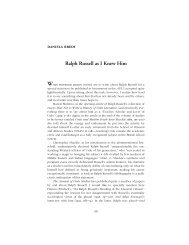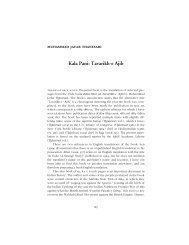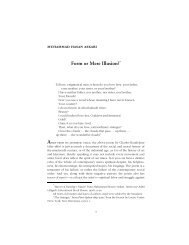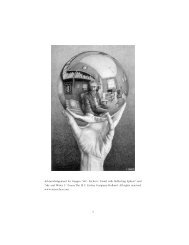Remarks on Ara'ish-e Mahfil by Mir Sher 'Ali Afsos - the Annual of ...
Remarks on Ara'ish-e Mahfil by Mir Sher 'Ali Afsos - the Annual of ...
Remarks on Ara'ish-e Mahfil by Mir Sher 'Ali Afsos - the Annual of ...
You also want an ePaper? Increase the reach of your titles
YUMPU automatically turns print PDFs into web optimized ePapers that Google loves.
DANIELA BREDI<str<strong>on</strong>g>Remarks</str<strong>on</strong>g> <strong>on</strong> Ara’ish-e <strong>Mahfil</strong><strong>by</strong> <strong>Mir</strong> <strong>Sher</strong> ‘Ali <strong>Afsos</strong>IN <strong>the</strong> F<strong>on</strong>do Borgia <strong>of</strong> <strong>the</strong> Vatican Library, under <strong>the</strong> listing Ind 13,<strong>the</strong>re is a ra<strong>the</strong>r curious manuscript, not <strong>the</strong> less for being, as it so far appears,<strong>the</strong> <strong>on</strong>ly <strong>on</strong>e in <strong>the</strong> Urdu language existing in this library. It has todo with a well-known work entitled ¥r≥’ish-e Ma√fil, compiled <strong>by</strong> anauthor—equally familiar to those who study Urdu language and literature—MµrSh®r ‘Alµ Afsås. This manuscript, which bears <strong>the</strong> date 1839(though <strong>the</strong> work had already been printed in Calcutta in 1808 <strong>by</strong> <strong>the</strong>plates <strong>of</strong> <strong>the</strong> Hindustani Press <strong>of</strong> Fort William College), is composed <strong>of</strong>two volumes (<strong>of</strong> 428 pages and 232 pages, respectively) measuring 20cm<strong>by</strong> 16cm. It was copied, as a note at <strong>the</strong> end <strong>of</strong> volume two says, <strong>by</strong> HenryO’Gorman, pr<strong>of</strong>essor <strong>of</strong> Hindustani and Persian, and revised <strong>by</strong> <strong>the</strong> vakµl<strong>of</strong> <strong>the</strong> deposed r≥j≥ <strong>of</strong> Satara (Bombay), Maulvµ Mµr Af¤al ‘Alµ. The lettersµn at <strong>the</strong> beginning <strong>of</strong> each secti<strong>on</strong> shows that <strong>the</strong> manuscript underwentrevisi<strong>on</strong>, and ano<strong>the</strong>r note explains that O’Gorman (whose L<strong>on</strong>d<strong>on</strong>address, dated 1854, is given) was a learned scholar <strong>of</strong> oriental languages,particularly <strong>of</strong> Hindustani. 1 After having been presented to Pius IX, <strong>the</strong>manuscript was given <strong>by</strong> him to <strong>the</strong> Museum <strong>of</strong> <strong>the</strong> British College in1860, and <strong>the</strong> annotati<strong>on</strong> “seen and at places corrected <strong>by</strong> Riy≥zu ’l-ƒasan1 For a l<strong>on</strong>g time <strong>the</strong> term Hindustani referred to <strong>the</strong> language in which thismanuscript was written—whe<strong>the</strong>r, as in this case, it was written with Perso-Arabic characters or with Devanagri characters—before <strong>the</strong> difference in scriptand symbology (culled from <strong>the</strong> writing <strong>by</strong> <strong>the</strong> Muslim community and <strong>by</strong> <strong>the</strong>Hindu) combined with various politico-cultural motivati<strong>on</strong>s, established <strong>the</strong>bifurcati<strong>on</strong> into Hindi and Urdu, <strong>by</strong> now separated languages, as we shall shortlyhave occasi<strong>on</strong> to see fur<strong>the</strong>r.33
34 • THE ANNUAL OF URDU STUDIES<strong>of</strong> Jaunpur (U.P.), Roma 27.1.1945” perhaps indicates <strong>the</strong> scant interestthat this gift has generated if no <strong>on</strong>e has bo<strong>the</strong>red about it for nearly acentury.If it is perhaps proper to bring to light a manuscript which held anotable importance in <strong>the</strong> orientalist culture <strong>of</strong> <strong>the</strong> last century, a greaterreas<strong>on</strong> to talk about it lies in <strong>the</strong> interest in <strong>the</strong> c<strong>on</strong>tent <strong>of</strong> <strong>the</strong> work.The report <strong>of</strong> <strong>the</strong> presence in <strong>the</strong> Vatican Library <strong>of</strong> thismanuscript—which c<strong>on</strong>sists <strong>of</strong> a general descripti<strong>on</strong> <strong>of</strong> <strong>the</strong> area aroundDelhi, with a brief history <strong>of</strong> <strong>the</strong> Hindu rulers preceding <strong>the</strong> Muslimc<strong>on</strong>quest, and whose compilati<strong>on</strong> is based <strong>on</strong> a Persian work which itlargely translates, entitled Khul≥Ωatu ’t-Tav≥rµkh <strong>by</strong> Munshµ Sujan R≥’® <strong>of</strong>Patiala—provides <strong>the</strong> occasi<strong>on</strong> to make certain remarks about ¥r≥’ish-eMa√fil. 2 We are in fact dealing with an example <strong>of</strong> Urdu historiography—although<strong>the</strong> book has <strong>the</strong> peculiarity <strong>of</strong> having been used for <strong>the</strong>most part not as an historical text but as a text for studying <strong>the</strong> Urdu language3 —which gives us <strong>the</strong> opportunity to take up <strong>the</strong> discussi<strong>on</strong> <strong>of</strong> thislanguage, its various fortunes and its prospects—a topic that is particularlytimely given <strong>the</strong> debate in progress, especially in Pakistan, over <strong>the</strong>suitability <strong>of</strong> using Urdu as a linguistic tool for history. 4First <strong>of</strong> all it seems worthwhile to recall that <strong>the</strong> author, Mµr Sh®r ‘AlµAfsås, a Saiyid, whose ancestors arrived in India from Iran, and whosefa<strong>the</strong>r had served as an <strong>of</strong>ficial with various nav≥bs, was born in Delhi in1732 and, following in his fa<strong>the</strong>r’s footsteps, at 27 entered <strong>the</strong> court <strong>of</strong> amember <strong>of</strong> <strong>the</strong> reigning family <strong>of</strong> Lucknow; he <strong>the</strong>n passed <strong>on</strong> to that <strong>of</strong><strong>the</strong> eldest s<strong>on</strong> <strong>of</strong> <strong>the</strong> emperor Sh≥h ‘¥lam, <strong>Mir</strong>z≥ Jav≥n Bakht, who hadmoved to <strong>the</strong> capital <strong>of</strong> <strong>the</strong> Oudh. There <strong>the</strong> n≥’ib <strong>of</strong> <strong>the</strong> Nav≥b ¥Ωafu ’d-Daula introduced him to <strong>the</strong> British Resident, up<strong>on</strong> whose recommenda-2 Three editi<strong>on</strong>s <strong>of</strong> it were printed in Calcutta, in 1808, 1848 and 1863, andCourt’s translati<strong>on</strong> into English was published twice (Allahabad, 1871; Calcutta,1882). Two selecti<strong>on</strong>s in English were drawn from Court: <strong>on</strong>e, <strong>the</strong> more famous<strong>by</strong> J. Shakespeare in 1817–18, with <strong>the</strong> title Muntakhab≥t-e Hind, and <strong>the</strong> o<strong>the</strong>r <strong>by</strong>N. L. Behmohel, published in Dublin in 1847. O<strong>the</strong>r manuscript copies <strong>of</strong> thiswork are located in <strong>the</strong> British Library and <strong>the</strong> India Office Library—as a fur<strong>the</strong>rdem<strong>on</strong>strati<strong>on</strong> <strong>of</strong> its diffusi<strong>on</strong> and popularity.3 For a l<strong>on</strong>g time, in fact, it remained <strong>on</strong>e <strong>of</strong> <strong>the</strong> texts for <strong>the</strong> High Pr<strong>of</strong>iciencyexam in Urdu for <strong>the</strong> junior members <strong>of</strong> Her Majesty’s Indian Civil andMilitary Services—as <strong>on</strong>e can read <strong>on</strong> <strong>the</strong> fr<strong>on</strong>tispiece <strong>of</strong> <strong>the</strong> printed editi<strong>on</strong>edited <strong>by</strong> W. N. Lees (Calcutta, 1871).4 Cf. K.K. Aziz, The Pakistani Historian (Delhi, 1994), ch. 4.
DANIELA BREDI • 35ti<strong>on</strong> he went to Calcutta in 1800 to be taken <strong>on</strong> as head munshµ <strong>of</strong> <strong>the</strong>Hindustani Department <strong>of</strong> Fort William College. He, who had mixedwith famous poets at <strong>the</strong> court <strong>of</strong> Lucknow—where Urdu literature hadenjoyed a renewed splendor after <strong>the</strong> decline <strong>of</strong> Delhi—and who wasalready known as a poet (author <strong>of</strong> a dµv≥n which had had much success),became part <strong>of</strong> this instituti<strong>on</strong> from <strong>the</strong> moment <strong>of</strong> its foundati<strong>on</strong>,which, despite <strong>the</strong> poor opini<strong>on</strong> expressed <strong>by</strong> noted authorities, 5 hadsuch a great part in <strong>the</strong> development <strong>of</strong> <strong>the</strong> Urdu language.In 1800 <strong>the</strong> <strong>the</strong>n-general <strong>of</strong> <strong>the</strong> East India Company, Lord Wellesley,founded Fort William College so that <strong>the</strong> <strong>of</strong>ficials <strong>of</strong> <strong>the</strong> Company, arrivingin India, would receive <strong>the</strong> instructi<strong>on</strong> necessary to carry out <strong>the</strong> tasksthat awaited <strong>the</strong>m, and particularly a knowledge <strong>of</strong> <strong>the</strong> Indian languageswhich was indispensable to <strong>the</strong>ir duties. Until <strong>the</strong>n no particular knowledgewas thought necessary to become an <strong>of</strong>ficial <strong>of</strong> <strong>the</strong> Company inIndia; but Wellesley (who had mastered Urdu and knew Persian) hadcultivated a notable interest in Indian culture, that translated itself into<strong>the</strong> foundati<strong>on</strong> <strong>of</strong> <strong>the</strong> Madrasa <strong>of</strong> Calcutta in 1780, into <strong>the</strong>attempt—though fruitless—to have a chair <strong>of</strong> Persian established atOxford, and into <strong>the</strong> move to create <strong>the</strong> Asiatic Society <strong>of</strong> Bengal in 1784.N<strong>on</strong>e<strong>the</strong>less, <strong>the</strong> goal <strong>of</strong> <strong>the</strong> College he wanted was not to give a fur<strong>the</strong>rboost to oriental studies, academically understood, but proposed, mostpragmatically, to make <strong>the</strong> administrati<strong>on</strong> <strong>of</strong> <strong>the</strong> Indian possessi<strong>on</strong>soperate at its best <strong>by</strong> putting at <strong>the</strong> Company’s disposal people trainedspecifically to work in India. According to Wellesley’s plans such a goalwould have been met <strong>by</strong> an educati<strong>on</strong> in which knowledge related toIndia would be integrated with Western knowledge <strong>of</strong> a scientific andliterary sort, devising a curriculum which would <strong>the</strong>n be used in schoolsfor training <strong>of</strong>ficials <strong>of</strong> public administrati<strong>on</strong>. 6 According to Wellesley <strong>the</strong>syllabus should include Law, History, Geography, Political Ec<strong>on</strong>omy,5 Muhammad Sadiq, A History <strong>of</strong> Urdu Literature (L<strong>on</strong>d<strong>on</strong>: Oxford UniversityPress, 1964), p. 211.6 When, in 1853, an act <strong>of</strong> Parliament established that <strong>the</strong> appointments to<strong>the</strong> Indian Civil Service had to be <strong>by</strong> examinati<strong>on</strong> and, in 1854, a Committee,headed <strong>by</strong> Lord Macauley, was nominated, which established <strong>the</strong> requirementsfor <strong>of</strong>ficials, <strong>the</strong> recommendati<strong>on</strong>s that were drawn up turned out to be perfectlyin sympathy with Secti<strong>on</strong> II <strong>of</strong> <strong>the</strong> Statutes entitled Admissi<strong>on</strong> <strong>of</strong> <strong>the</strong> SuperiorOfficers and Pr<strong>of</strong>essors <strong>of</strong> Fort William College. Reported in S.K. Das, Sahibsand Munshis (Calcutta, 1978), pp. 7–8.
36 • THE ANNUAL OF URDU STUDIESChemistry, Botany, Philosophy, as well as Greek, Latin, Sanskrit, Arabicand Persian, French and various Indian languages. Law should includeBritish as well as Hindu and Muslim law in additi<strong>on</strong> to <strong>the</strong> laws enforced<strong>by</strong> <strong>the</strong> Governors General <strong>of</strong> <strong>the</strong> Company. And History should includeboth European and Indian history. Learning <strong>the</strong> languages in use in Indiawas indispensable, but had to go side <strong>by</strong> side with knowledge <strong>of</strong> classicallanguages, both Western and Eastern. Although <strong>on</strong>ly Westerners could benamed pr<strong>of</strong>essors, <strong>the</strong>y had to be supported <strong>by</strong> munshµs 7 <strong>of</strong> various ranks.The pr<strong>of</strong>essor and munshµ <strong>of</strong> <strong>the</strong> Hindustani Department—respectivelyGilchrist and Afsås—were particularly important, for though Wellesleyhad foreseen six chairs <strong>of</strong> modern Indian languages, <strong>the</strong> difficulties <strong>of</strong>costs to <strong>the</strong> Directors <strong>of</strong> <strong>the</strong> Company made it possible to institute <strong>on</strong>ly<strong>on</strong>e, namely that in Hindustani.Gilchrist’s role (which Afsås defines, in <strong>the</strong> introducti<strong>on</strong> to ¥r≥’ish-eMa√fil, as Ω≥√ab mudarris-e hindµ, dem<strong>on</strong>strating how interchangeable <strong>the</strong>terms for denoting <strong>the</strong> language still were at <strong>the</strong> time 8 ) was very importantto <strong>the</strong> development <strong>of</strong> Hindustani and, in particular, <strong>of</strong> prose, as hemade a special effort to create a style which was informal without beingrough, and elegant without being pompous. The fact that <strong>the</strong> group <strong>of</strong>writers at Fort William, supported <strong>by</strong> him to produce works <strong>of</strong> this sort,cannot <strong>by</strong> defined as a real literary movement does not mean that <strong>the</strong>ydid not have a decisive influence <strong>on</strong> <strong>the</strong> evoluti<strong>on</strong> <strong>of</strong> <strong>the</strong> language. For astylistic change effectively took place immediately afterwards—not <strong>on</strong>lyin works destined for Europeans, but also in those for regi<strong>on</strong>al circulati<strong>on</strong>—asis evident from <strong>the</strong> works <strong>of</strong> <strong>the</strong> movement <strong>of</strong> <strong>the</strong> so-calledWahhabi Indians and from <strong>the</strong> producti<strong>on</strong>s <strong>of</strong> <strong>the</strong> Old Dilli College. 9Gilchrist and his fourteen munshµs, headed <strong>by</strong> Afsås, produced, in fouryears, sixty works in Hindustani, or relative to Hindustani—some inDevanagri characters—which, <strong>by</strong> <strong>the</strong> fact <strong>of</strong> being printed, produced a7 In India this term, which means “writer”—both in <strong>the</strong> sense <strong>of</strong> author and<strong>of</strong> scribe—took to meaning (especially am<strong>on</strong>g Europeans) a language teacher,especially <strong>of</strong> Urdu or Persian, with <strong>the</strong> sense <strong>of</strong> an expert <strong>of</strong> <strong>the</strong> language.8 M. D. ¿iddµqµ, Gilkir≥’isª aur us k≥ ‘Ahd, (New Delhi, 1979), p. 26.9 S. R. Kidwai, Gilchrist and <strong>the</strong> ‘Language <strong>of</strong> Hindoostan’ (New Delhi, 1972),p. viii.
DANIELA BREDI • 37small revoluti<strong>on</strong> in <strong>the</strong> world <strong>of</strong> Indian languages, 10 as became evidentsome thirty years later with <strong>the</strong> birth <strong>of</strong> Urdu journalism. The demand <strong>of</strong>teaching Westerners a language in which <strong>the</strong>y could communicate with(not necessarily educated) Indians in fact laid <strong>the</strong> ground work for alinguistic evoluti<strong>on</strong> <strong>of</strong> fundamental importance, even though <strong>the</strong> workimmediately derived from it certainly cannot be c<strong>on</strong>sidered “literature” in<strong>the</strong> strict sense. It is in fact true that no educated pers<strong>on</strong> has ever readAfsås or Mµr Amman’s books, 11 and so <strong>on</strong>e cannot say that a direct influenceexists between this sort <strong>of</strong> text and <strong>the</strong> prose <strong>of</strong> Gh≥lib or SaiyidA√mad Kh≥n; but it is equally true that modern Urdu, as a linguisticmeans capable <strong>of</strong> expressing any c<strong>on</strong>cept, owes much to Fort WilliamCollege.A fur<strong>the</strong>r remark is necessary about <strong>the</strong> work <strong>of</strong> Fort William Collegein <strong>the</strong> linguistic and cultural domain (whose implicati<strong>on</strong>s it will be necessaryto take up later <strong>on</strong>): namely that it is precisely to this instituti<strong>on</strong> that<strong>on</strong>e can trace <strong>the</strong> Hindi-Urdu dichotomy which would become primarilya political issue. It was in fact <strong>the</strong> authorities <strong>of</strong> <strong>the</strong> College who encouraged,at <strong>the</strong> insistence <strong>of</strong> <strong>the</strong> East India Company, two parallel groups <strong>of</strong>writers from within <strong>the</strong> Hindustani Department: <strong>on</strong>e which used <strong>the</strong>Perso-Arabic script for its own writings and maintained a style tied toPersian, as <strong>the</strong> educated language <strong>of</strong> <strong>the</strong> Muslim world; and <strong>the</strong> o<strong>the</strong>rwhich used <strong>the</strong> Devanagri characters derived from Sanskrit, and whichtried to Indianize—meaning, Sanskritize—<strong>the</strong> language as much aspossible. 12 The Hindi-Urdu c<strong>on</strong>troversy would affect <strong>the</strong> politicoculturalscene in India for more than a century, for <strong>the</strong> Indian Muslimssaw in <strong>the</strong> birth <strong>of</strong> Hindi a fur<strong>the</strong>r threat to <strong>the</strong>ir own identity andano<strong>the</strong>r attempt to expel <strong>the</strong> Muslim c<strong>on</strong>tributi<strong>on</strong> from India, denying<strong>the</strong>m <strong>the</strong> title <strong>of</strong> “indianness,” so to speak. In fact, it is quite true thatUrdu, its birth, its development and history are tightly bound to <strong>the</strong>Muslim presence in India, but it is equally true that until <strong>the</strong> birth <strong>of</strong>Hindi <strong>the</strong> language was <strong>the</strong> expressi<strong>on</strong> <strong>of</strong> Indian culture without o<strong>the</strong>rimplicati<strong>on</strong>s, nor did its use have any religious c<strong>on</strong>notati<strong>on</strong>s.10 Fort William College had its own press which, al<strong>on</strong>g with o<strong>the</strong>rs thatsprang up in <strong>the</strong> same period <strong>of</strong> time, c<strong>on</strong>tributed to a revival <strong>of</strong> Indian languages,in additi<strong>on</strong> to <strong>the</strong> spread <strong>of</strong> English.11 Kidwai, p. 28–9.12 Cf. Ali Jawad Zaidi, A History <strong>of</strong> Urdu Literature (New Delhi: SahityaAkademi, 1993), p. 211.
38 • THE ANNUAL OF URDU STUDIESParadoxically, it was exactly in <strong>the</strong> period <strong>of</strong> Mughal decline that agreat cultural turmoil caused Urdu to emerge, in <strong>the</strong> place <strong>of</strong> Persian, asan important form <strong>of</strong> expressi<strong>on</strong> as well as a means <strong>of</strong> “high” communicati<strong>on</strong>,promoting it from a vernacular to a literary language. Until <strong>the</strong>n,with <strong>the</strong> excepti<strong>on</strong> <strong>of</strong> <strong>the</strong> Deccan where <strong>the</strong> Muslim sultans had adopted<strong>the</strong> Dakhni variants as <strong>the</strong> principal cultural vehicle, 13 <strong>the</strong> imperialMughal government had always accorded Persian <strong>the</strong> rank <strong>of</strong> <strong>of</strong>ficiallanguage. It was in fact Akbar himself who extended Persian all <strong>the</strong> way to<strong>the</strong> administrati<strong>on</strong> (even at <strong>the</strong> local level), dem<strong>on</strong>strating a pr<strong>of</strong>oundrespect for <strong>the</strong> Persian culture that tied him to <strong>the</strong> internati<strong>on</strong>al Muslimcommunity. The Mughals knowingly pursued a policy <strong>of</strong> cultural leadershipin India, to which <strong>the</strong> favor accorded to Persian bel<strong>on</strong>ged. TheMughal ideas <strong>of</strong> leadership, al<strong>on</strong>g with <strong>the</strong> mysticism <strong>of</strong> <strong>the</strong>ir CentralAsian lineage, involved ambiti<strong>on</strong>s outside India, especially bey<strong>on</strong>d <strong>the</strong>north-western border, though <strong>the</strong>se declined definitively in <strong>the</strong> periodfollowing <strong>the</strong> reign <strong>of</strong> Shah Jahan, after which <strong>the</strong> Mughal pretenses nol<strong>on</strong>ger found any justificati<strong>on</strong> at <strong>the</strong> internati<strong>on</strong>al level.Both <strong>the</strong> protecti<strong>on</strong> <strong>of</strong> <strong>the</strong> Persian language and <strong>the</strong>ir ambiti<strong>on</strong>s inforeign policy were important factors in maintaining <strong>the</strong> ties <strong>of</strong> <strong>the</strong>Mughal aristocracy with Islamic society and culture in general, but both<strong>of</strong> <strong>the</strong>se lines failed. Persian scholars never took <strong>the</strong> Persian works <strong>of</strong> <strong>the</strong>irIndian peers seriously, while India suffered invasi<strong>on</strong>s <strong>by</strong> N≥dir Sh≥h andA√mad Sh≥h Abd≥lµ (who sacked Delhi twice). So, even though <strong>the</strong> study<strong>of</strong> Persian c<strong>on</strong>tinued to be part <strong>of</strong> <strong>the</strong> curriculum <strong>of</strong> Indian Muslim intellectuals,at <strong>the</strong> beginning <strong>of</strong> <strong>the</strong> eighteenth century <strong>the</strong> Muslims <strong>of</strong> nor<strong>the</strong>rnIndia turned toward Urdu. In this, as in o<strong>the</strong>r senses, <strong>the</strong> l<strong>on</strong>g reign<strong>of</strong> Aurangzeb (1658–1707) c<strong>on</strong>stituted a watershed, for it saw a decisivedecline in imperial patr<strong>on</strong>age with regard to Persian scholars, and a c<strong>on</strong>sequentdecline in migrati<strong>on</strong> from Iran. In this sense, Aurangzeb wasra<strong>the</strong>r more “Indian” than his predecessors, given that he focused hispolitical attenti<strong>on</strong>s <strong>on</strong> <strong>the</strong> Subc<strong>on</strong>tinent, neglecting ties with internati<strong>on</strong>alIslam.The most important fact, however, resides in <strong>the</strong> change, from <strong>the</strong>n<strong>on</strong>, in <strong>the</strong> audience which literature addressed. Indian writers who adopt13 Cf. D. J. Mat<strong>the</strong>ws, “The Kulliy≥t <strong>of</strong> Muhammad Qulµ Qutb Sh≥h: problemsand prospects” in Urdu and Muslim South Asia, ed. Christopher Shackle,(L<strong>on</strong>d<strong>on</strong>: L<strong>on</strong>d<strong>on</strong> University, School <strong>of</strong> Oriental and African Studies, 1989), pp.39–48.
DANIELA BREDI • 39Urdu no l<strong>on</strong>ger address an internati<strong>on</strong>al audience, but an Indian <strong>on</strong>e.And <strong>the</strong>y no l<strong>on</strong>ger have <strong>the</strong> emperor and his court for a privileged interlocutor,but a much larger public, though still aristocratic. This broadeningis unequivocally attested to <strong>by</strong> <strong>the</strong> fact that <strong>the</strong>y went so far indeed asto translate <strong>the</strong> Qur’an into Urdu, in order to make it accessible toMuslims who did not know <strong>the</strong> classical languages <strong>of</strong> Islamic culture. 14 Insuch a way, <strong>the</strong> preference from this period <strong>on</strong>ward <strong>of</strong> Indian Muslims <strong>of</strong><strong>the</strong> North to regi<strong>on</strong>al-cultural identity, ra<strong>the</strong>r than to universal Islamicidentity, becomes apparent. And in <strong>the</strong> same vein, according to some,should also be seen <strong>the</strong> Pakistani attempts to declare Urdu as <strong>the</strong> nati<strong>on</strong>allanguage, in <strong>the</strong> search for its own cultural identity. 15One literary genre in particular showed itself free <strong>of</strong> clichés from <strong>the</strong>Persian models. And it is <strong>the</strong> shahr ≥shåb, <strong>the</strong> epic or narrative poem <strong>of</strong>current political <strong>the</strong>mes, particularly rich in Indian images, terms andreferences, with which poets <strong>of</strong> <strong>the</strong> highest order tested <strong>the</strong>mselves: viz.,Saud≥, Mµr Taqµ Mµr, Na µr Akbar≥b≥dµ, and even <strong>the</strong> last tragic Mughalemperor, Bahadur Shah II, who under <strong>the</strong> nom de plume <strong>of</strong> ◊afar, wrote apoem <strong>of</strong> this type. This dem<strong>on</strong>strates <strong>the</strong> deep interest that current affairsheld for intellectuals, acutely aware <strong>of</strong> <strong>the</strong> changes which were takingplace in <strong>the</strong> society to which <strong>the</strong>y bel<strong>on</strong>ged. 16The actual writing <strong>of</strong> history deserves a separate discussi<strong>on</strong>. At <strong>the</strong>end <strong>of</strong> <strong>the</strong> eighteenth and <strong>the</strong> beginning <strong>of</strong> <strong>the</strong> nineteenth centuries Urdualso emerged as a language capable <strong>of</strong> producing works <strong>of</strong> history, coincidingwith <strong>the</strong> introducti<strong>on</strong> <strong>of</strong> English historiography into India. Urduhistoriography, <strong>the</strong>refore, developed in a traditi<strong>on</strong> <strong>of</strong> <strong>the</strong> decline <strong>of</strong> Indo-Persian and <strong>the</strong> emergence <strong>of</strong> Western historiography; and it is <strong>the</strong> firstindigenous language, in <strong>the</strong> modern era, to undertake <strong>the</strong> producti<strong>on</strong> <strong>of</strong>historical works.As early as <strong>the</strong> period preceding <strong>the</strong> founding <strong>of</strong> Fort St. GeorgeCollege at Madras, <strong>of</strong> Fort William College at Calcutta, and <strong>of</strong> DehliCollege, <strong>on</strong>e finds a few works <strong>of</strong> an historical nature in Urdu, as, for14 Sh≥h Valµu ’l-L≥h (1703–1762) translated <strong>the</strong> Qur’an into Persian, and hiss<strong>on</strong>s Rafµ‘u ’d-Dµn: and ‘Abdu ’l-Q≥dir made two translati<strong>on</strong>s <strong>of</strong> it into Urdu, <strong>on</strong>ein 1780 and <strong>the</strong> o<strong>the</strong>r in 1790.15 M. G. S. Hodgs<strong>on</strong>, “The Unity <strong>of</strong> Later Islamic History,” Cahiers d’HistoireM<strong>on</strong>diale 4 (1960), 911 n.16 Fritz Lehman, “Urdu Literature and Mughal Decline,” <strong>Mahfil</strong>, vol. VI(Spring 1970), pp. 125–31.
40 • THE ANNUAL OF URDU STUDIESexample, that <strong>of</strong> Saiyid Bijnaurµ (from 1772) entitled QiΩΩa va A√v≥l-eRåhila. From this and o<strong>the</strong>r examples <strong>of</strong> Urdu historiography <strong>of</strong> thisperiod—whe<strong>the</strong>r <strong>on</strong>e is speaking <strong>of</strong> original works or translati<strong>on</strong>s orabridged translati<strong>on</strong>s <strong>of</strong> histories in Persian—<strong>on</strong>e finds that this type <strong>of</strong>work was usually undertaken <strong>on</strong> commissi<strong>on</strong>, <strong>of</strong>ten from English <strong>of</strong>ficials,and that <strong>the</strong> topics dealt with were always related to India, understoodboth in its totality and in its regi<strong>on</strong>al particularities. The language variouslycalled <strong>by</strong> <strong>the</strong>ir authors Hindi-Urdu, Urdu or Dakhni, is in generalquite simple, but <strong>of</strong>ten interspersed with Persian or local languages. Only<strong>on</strong> rare occasi<strong>on</strong>s are sources menti<strong>on</strong>ed, even when it comes to famousauthors, such as Mun‘im Kh≥n Aurag≥b≥dµ, 17 who certainly had accesseven to state documents. Then, apart from this last historian, it does notseem as though <strong>the</strong> authors <strong>of</strong> historical works had a particular specializati<strong>on</strong>in writing history, ra<strong>the</strong>r that <strong>the</strong>y were simply c<strong>on</strong>cerned withga<strong>the</strong>ring a certain amount <strong>of</strong> informati<strong>on</strong> requested <strong>by</strong> <strong>the</strong>ir clients(who, very <strong>of</strong>ten, having a ra<strong>the</strong>r vague noti<strong>on</strong> <strong>of</strong> it, were not muchc<strong>on</strong>cerned with historiography). According to some, <strong>the</strong>refore, <strong>the</strong>seinitial works do not have scientific merit but c<strong>on</strong>stitute a mere example <strong>of</strong>how a given genre may begin. 18One should not be surprised, <strong>the</strong>refore, that Afsås began with aPersian translati<strong>on</strong>, nor that his noti<strong>on</strong> <strong>of</strong> history, in <strong>the</strong> final analysis,does not break with that <strong>of</strong> <strong>the</strong> mediaeval political chr<strong>on</strong>iclers who wrotein Persian. In <strong>the</strong> preface to <strong>the</strong> ¥r≥’ish-e Ma√fil he in fact dem<strong>on</strong>stratesthat he is aware <strong>of</strong> having dealt <strong>on</strong>ly with <strong>the</strong> powerful when he maintainsthat <strong>the</strong> history <strong>of</strong> <strong>the</strong> Hindu kings “in reality hands down <strong>on</strong>ly <strong>the</strong>names <strong>of</strong> <strong>the</strong> most important people, <strong>of</strong> whom in our days nothing is left,not even <strong>the</strong> lineage, no sign <strong>of</strong> <strong>the</strong>m in <strong>the</strong> world.” And as <strong>the</strong> <strong>on</strong>ly wayto leave a lasting sign is to “protect <strong>the</strong> people, to keep <strong>the</strong> state inc<strong>on</strong>stant development, to wield justice firmly,” <strong>the</strong> purpose that movesAfsås—though he works at <strong>the</strong> behest <strong>of</strong> <strong>the</strong> English—is, like that <strong>of</strong> hispredecessors who expressed <strong>the</strong>mselves in Persian, religious, moral, andabove all didactic. As Nizami has well explained, 19 mediaeval Indianhistorians c<strong>on</strong>sidered history principally a search for truth, and above all17 Active during <strong>the</strong> reign <strong>of</strong> <strong>the</strong> Nizam <strong>of</strong> Hyderabad ‘Alµ Kh≥n ¥Ωaf J≥h.18 Javed Ali Khan, “Beginning <strong>of</strong> Historical Writings in Urdu,” Journal <strong>of</strong> <strong>the</strong>Pakistan Historical Society, vol. XLII, Part I (Jan. 1994), pp. 23–35.19 K. A. Nizami, On History and Historians <strong>of</strong> Medieval India (New Delhi,1983), pp. 43–5.
DANIELA BREDI • 41Baranµ; <strong>the</strong>y had a <strong>the</strong>ory <strong>of</strong> history and a precise idea <strong>of</strong> <strong>the</strong> duties <strong>of</strong> <strong>the</strong>historian, am<strong>on</strong>g which are patience and <strong>the</strong> teaching <strong>of</strong> submissi<strong>on</strong> to<strong>the</strong> wishes <strong>of</strong> God, and <strong>the</strong> expurgati<strong>on</strong> <strong>of</strong> false faiths which lead towr<strong>on</strong>g truths. And here again Afsås shows himself to be perfectly in linewith such a <strong>the</strong>ory when he affirms (again in <strong>the</strong> preface) that he made aneffort to “correct <strong>the</strong> errors,” and that in <strong>the</strong> translati<strong>on</strong> he has favored <strong>the</strong>administrati<strong>on</strong> <strong>of</strong> <strong>the</strong> provinces. And with regard to <strong>the</strong> places hedescribes, where pr<strong>of</strong>ound changes sometimes occurred, he declares tha<strong>the</strong> was <strong>on</strong>ly interested in <strong>the</strong> tombs and holdings <strong>of</strong> <strong>the</strong> Sufi when speaking<strong>of</strong> places <strong>of</strong> worship; while with regard to <strong>the</strong> Hindu mystics and <strong>the</strong>irholy places, he says candidly that he has not taken <strong>the</strong>m into c<strong>on</strong>siderati<strong>on</strong>as <strong>the</strong>y are c<strong>on</strong>trary to religi<strong>on</strong> and faith, and “because this is<strong>the</strong> religi<strong>on</strong> <strong>of</strong> <strong>the</strong> inferior.” He does not shy away from invoking ‘Alµ as aguide and claiming that “<strong>the</strong> human being needs to know and to adore<strong>the</strong> Creator according to his own religi<strong>on</strong>, and he should not know thosethat are false; and because with time <strong>the</strong> pagan cults become heresies it isnecessary to stick to correct knowledge.” And he adds: “God save us fromuseless knowledge!” He c<strong>on</strong>tinues, saying that, never<strong>the</strong>less, he has d<strong>on</strong>eall that is necessary to avoid spreading errors, for it is not appropriate toindulge in things <strong>of</strong> little worth: life is too serious to take <strong>the</strong>m intoc<strong>on</strong>siderati<strong>on</strong> until <strong>the</strong> necessary and obligatory things have beenobtained. “When dealing with sovereigns and rulers, as <strong>on</strong>e learns <strong>of</strong> <strong>the</strong>good and evil <strong>of</strong> past kings, <strong>on</strong>e must choose <strong>the</strong> good and pass over <strong>the</strong>evil so that <strong>the</strong>ir reigns not be a bad example and endanger <strong>the</strong> state.”And he c<strong>on</strong>cludes that in this way history is “guide and knowledge,because when <strong>the</strong> human being is aware <strong>of</strong> which and how many lordsand powerful kings, despite <strong>the</strong>ir retinue and wealth, have died out, and<strong>of</strong> whom not even <strong>the</strong> traces <strong>of</strong> a tomb are left, he would not perhapsdesire to have ei<strong>the</strong>r followers or kingdoms.” And he c<strong>on</strong>tinues: “Theworld and worldliness should be c<strong>on</strong>sidered fleeting things, and <strong>the</strong> o<strong>the</strong>rworld and that which is inherent to it should be c<strong>on</strong>sidered immortalthings. What has become <strong>of</strong> ambitious sovereigns? For <strong>the</strong>m too <strong>the</strong> place<strong>of</strong> repose is <strong>the</strong> dust. Of those who were glorious and splendid princesnothing remains but tombs; <strong>the</strong> heads that bore golden crowns are nothingbut skulls covered with dust—while <strong>on</strong> <strong>the</strong> page remains written <strong>the</strong>good and bad <strong>the</strong>y did.”Therefore <strong>the</strong> ¥r≥’ish-e Ma√fil is without a doubt a dynastic historywith moral and didactic intenti<strong>on</strong>s, and not without its own originality(though a translati<strong>on</strong>) precisely because, <strong>by</strong> express declarati<strong>on</strong> <strong>of</strong> <strong>the</strong>author, we are dealing with a willfully unfaithful translati<strong>on</strong>. Perhaps it is
42 • THE ANNUAL OF URDU STUDIESfor this reas<strong>on</strong> that Garcin de Tassy c<strong>on</strong>siders this work <strong>the</strong> chief <strong>on</strong>e <strong>of</strong>Afsås, and deems it particularly useful as it c<strong>on</strong>tains general knowledgeabout India and <strong>the</strong> customs <strong>of</strong> its inhabitants, topographical descripti<strong>on</strong>s<strong>of</strong> <strong>the</strong> provinces, and <strong>the</strong> history <strong>of</strong> <strong>the</strong> rulers <strong>of</strong> Delhi from Yudshtir toPrit^vµ R≥’®. Above all, says De Tassy, <strong>on</strong>e may c<strong>on</strong>sider this work originalboth for <strong>the</strong> number <strong>of</strong> facts that have been taken from elsewhere andbecause <strong>of</strong>ten, instead <strong>of</strong> repeating <strong>the</strong> asserti<strong>on</strong>s <strong>of</strong> <strong>the</strong> Persian versi<strong>on</strong>, hehas corrected those he c<strong>on</strong>sidered errors. 20Regardless <strong>of</strong> <strong>the</strong> esteem <strong>of</strong> Garcin de Tassy, who translates largepieces <strong>of</strong> <strong>the</strong> ¥r≥’ish-e Ma√fil, this text, as we have already had occasi<strong>on</strong> tomenti<strong>on</strong>, was used primarily for language apprehensi<strong>on</strong>, as reading, andas a stylistic model, without heeding too much its value as history,perhaps because Urdu historiography was born in a moment <strong>of</strong> transiti<strong>on</strong>and is, in a certain sense, squashed between that <strong>of</strong> Persian and that <strong>of</strong>English, unable to glean <strong>the</strong> best <strong>of</strong> ei<strong>the</strong>r traditi<strong>on</strong>. And this brings us to<strong>the</strong> use <strong>of</strong> <strong>the</strong> Urdu language as a means for writing history, a topic whichclosely touches Pakistani intellectuals in particular.At <strong>the</strong> beginning <strong>of</strong> <strong>the</strong> nineteenth century—<strong>the</strong> period in whichAfsås’s work is situated—and particularly as a c<strong>on</strong>sequence <strong>of</strong> <strong>the</strong> impactwith Western culture and British works, <strong>the</strong>re was an effort to be rid <strong>of</strong>old stereotypes and to renew <strong>the</strong> language, making it suitable for <strong>the</strong>expositi<strong>on</strong> <strong>of</strong> any topic. And though this effort was carried <strong>on</strong>, so thateventually Urdu was able to resp<strong>on</strong>d positively to all <strong>the</strong> stages <strong>of</strong> nati<strong>on</strong>alhistorical development, opini<strong>on</strong>s are divided. There are those who holdthat Urdu succeeded in stripping itself <strong>of</strong> courtly traditi<strong>on</strong>s, highfalutinwords, artificial dicti<strong>on</strong> and stale images, and became a language able toreflect <strong>the</strong> psychological c<strong>on</strong>siderati<strong>on</strong>s, <strong>the</strong> emoti<strong>on</strong>al experiences, andeven <strong>the</strong> whisperings <strong>of</strong> <strong>the</strong> populace. And in doing so, it made room for<strong>the</strong> foundati<strong>on</strong> <strong>of</strong> new and vigorous schools born in resp<strong>on</strong>se to Westernstyleeducati<strong>on</strong> and modern lifestyles, such that <strong>on</strong>e can speak <strong>of</strong> an Urdurevival, <strong>of</strong> which ¥z≥d and ƒ≥lµ were <strong>the</strong> precursors. 21 But o<strong>the</strong>rs are not<strong>of</strong> <strong>the</strong> same opini<strong>on</strong>. Despite a c<strong>on</strong>spicuous number <strong>of</strong> authors <strong>of</strong> materialdefinable as scientific and historical, c<strong>on</strong>sidered models <strong>of</strong> clarity,20 M. Garcin de Tassy, Histoire de la Littérature Hindouie et Hindoustanie(Paris, 1970), vol. I, p. 37.21 Khwaja Ahmad Faruqi, “Urdu Literature,” in C<strong>on</strong>temporary Indian Literature(Delhi, 1959), pp. 264–81.
DANIELA BREDI • 43eruditi<strong>on</strong>, flexibility and research, 22 K.K. Aziz, for example, puts forwardserious and justifiable doubts that, as far as history is c<strong>on</strong>cerned, Urdu canbe a suitable language.This eminent Pakistani historian, without entering into <strong>the</strong> c<strong>on</strong>troversyabout whe<strong>the</strong>r Urdu is or could be or should be <strong>the</strong> nati<strong>on</strong>allanguage <strong>of</strong> his country, 23 poses <strong>the</strong> questi<strong>on</strong> <strong>of</strong> whe<strong>the</strong>r it is worthwhiletoday to choose Urdu as <strong>the</strong> language for writing history which is notmerely regi<strong>on</strong>al history. According to him <strong>the</strong> choice is between Englishand Urdu, and it does not depend <strong>on</strong>ly up<strong>on</strong> <strong>the</strong> pers<strong>on</strong>, his command <strong>of</strong><strong>the</strong> language, his educati<strong>on</strong> and cultural basis. After all, two historians <strong>of</strong><strong>the</strong> caliber <strong>of</strong> I.H. Qureshi and Aziz Ahmad, both native speakers <strong>of</strong>Urdu, chose English when it came to writing historiography.Leaving aside <strong>the</strong> advantages <strong>of</strong> English, it seems appropriate here tomenti<strong>on</strong> what this scholar states as far as Urdu is c<strong>on</strong>cerned. In <strong>the</strong> firstplace he maintains that no <strong>on</strong>e outside Pakistan and a few Indian citiesreads this language, so it is not adapted to explain historical questi<strong>on</strong>s to<strong>the</strong> world from an Indian Muslim point <strong>of</strong> view. If this point <strong>of</strong> view is tobe spread and made acceptable—taking away <strong>the</strong> m<strong>on</strong>opoly <strong>of</strong> historicalinterpretati<strong>on</strong> <strong>of</strong> <strong>the</strong> Subc<strong>on</strong>tinent from <strong>the</strong> Indians—<strong>the</strong> Pakistani historianwill have to renounce Urdu, for this means guarantees him a verylimited public. He would surely have readers, but in a society with a lowlevel <strong>of</strong> literacy <strong>the</strong>y would essentially be made up <strong>of</strong> those who, forvarious reas<strong>on</strong>s (<strong>the</strong> most prevalent <strong>of</strong> which are ideological) have aband<strong>on</strong>edEnglish or have never gained a good understanding <strong>of</strong> it. As itsaudience is limited to <strong>the</strong> lower classes and to younger students, historicalworks in Urdu occupy a ra<strong>the</strong>r weak positi<strong>on</strong>. Fur<strong>the</strong>rmore, Urdu charactersare relatively few and it is very difficult to quote extensively inlanguages which have a different alphabet, for this implies a c<strong>on</strong>siderableeffort <strong>of</strong> translati<strong>on</strong>. An effort that has not yet been undertaken, giventhat no <strong>on</strong>e has yet bo<strong>the</strong>red to translate <strong>the</strong> articles <strong>of</strong> Saiyid Amir ‘Ali,<strong>the</strong> writings <strong>of</strong> Agha Khan, <strong>the</strong> discourses <strong>of</strong> Muhammad ‘Ali, <strong>the</strong> documents<strong>of</strong> <strong>the</strong> All India Muslim League, <strong>the</strong> proceedings <strong>of</strong> <strong>the</strong> RoundTable C<strong>on</strong>ference, to name <strong>on</strong>ly a few <strong>of</strong> <strong>the</strong> myriad documents preservedat <strong>the</strong> India Office and in <strong>the</strong> British Public Record Office (not to speak<strong>of</strong> those existing in private holdings and archives, newspapers, etc.).As for its vocabulary, it would not be rich enough; moreover, its22 Ibid., p. 280.23 Aziz, pp. 154–7.
44 • THE ANNUAL OF URDU STUDIESphraseology would not be flexible enough to sustain <strong>the</strong> weight <strong>of</strong> asophisticated scientific prose, due to <strong>the</strong> scarcity <strong>of</strong> prose works and <strong>the</strong>language’s inability to develop its style according to <strong>the</strong> dictates <strong>of</strong>circumstances in c<strong>on</strong>tinual change. From its beginnings Urdu hasc<strong>on</strong>centrated <strong>on</strong> poetry and in particular <strong>on</strong> <strong>the</strong> ghazal, and so regardless<strong>of</strong> <strong>the</strong> richness <strong>of</strong> its literature, it is difficult to use it for philosophicalexplanati<strong>on</strong>s, or to describe c<strong>on</strong>stituti<strong>on</strong>al problems, or, even more so, totalk about law or <strong>the</strong> social sciences. And if <strong>on</strong>e adds to <strong>the</strong> scarcity <strong>of</strong>words <strong>the</strong> difficulty in articulating a complete sentence with manysubordinates—all while remaining comprehensible—<strong>on</strong>e arrives at <strong>the</strong>c<strong>on</strong>clusi<strong>on</strong> that Urdu prose is not suited to express sophisticated argumentsand intricate analyses, being intrinsically unable, in doing so, topreserve <strong>the</strong> fluidity <strong>of</strong> narrati<strong>on</strong>.Its style, too, appears particularly unsuitable to our critic, as it isanchored in <strong>the</strong> legacy <strong>of</strong> <strong>the</strong> Perso-Arabic past, so that peculiarities,mannerisms, customs and idiosyncrasies persist, which <strong>the</strong> modernreader—especially if used to <strong>the</strong> soberness <strong>of</strong> Western languages—findsstrange and difficult. In <strong>the</strong> first place he cites <strong>the</strong> habit <strong>of</strong> referring topeople exclusively <strong>by</strong> <strong>the</strong>ir h<strong>on</strong>orific title, which <strong>of</strong>ten even takes <strong>the</strong>place <strong>of</strong> <strong>the</strong>ir name. It is enough to take <strong>the</strong> example <strong>of</strong> Muhammad ‘AliJinnah who <strong>by</strong> now is ever <strong>the</strong> Qaid-i Azam. However, not all peoplehave been h<strong>on</strong>ored in this way, and so <strong>the</strong>re is already an implicit judgmentin <strong>the</strong> way <strong>of</strong> citing names. For example, Abul Kalam Azad is alwaysMawlana and Saiyid Amir ‘Ali and Saiyid A√mad Kh≥n are always cited <strong>by</strong><strong>the</strong>ir name without <strong>the</strong> title. Moreover, <strong>on</strong>ly Muslims are dignified in thisway, while o<strong>the</strong>r people appear deprived <strong>of</strong> any title whatsoever.Fur<strong>the</strong>rmore, as various ways exist in Urdu to refer to a pers<strong>on</strong> given <strong>the</strong>social rank he occupies and <strong>the</strong> level <strong>of</strong> respect he carries (e.g., <strong>on</strong>e alwaysrefers to a pers<strong>on</strong> <strong>of</strong> high rank and/or to <strong>on</strong>e who garners respect with <strong>the</strong>verb in <strong>the</strong> plural), <strong>the</strong> way in which a writer refers to some<strong>on</strong>e alreadyimplies a judgement and an evaluati<strong>on</strong>. Apart from this, <strong>the</strong>re are alsovarious ways to show admirati<strong>on</strong> or c<strong>on</strong>tempt at <strong>the</strong> disposal <strong>of</strong> those whowrite in Urdu, according to <strong>the</strong> verbs and turns <strong>of</strong> phrase employed. Totake a very simple example, <strong>the</strong> declarati<strong>on</strong>s <strong>of</strong> a Muslim leader areusually reported using <strong>the</strong> courteous verb farm≥n≥, while for those <strong>of</strong>o<strong>the</strong>rs <strong>on</strong>e simply uses kahn≥. Both verbs mean “to say,” but <strong>the</strong> value <strong>of</strong>what is said is much different according to <strong>the</strong> choice made. And <strong>on</strong>ecould take, as K. K. Aziz indeed does, many o<strong>the</strong>r examples.Again according to this author, Urdu grammar was fixed <strong>by</strong> Mughalimperialism, and <strong>the</strong> prose style <strong>by</strong> Muslim history. The Pakistani histo-
DANIELA BREDI • 45rian who uses Urdu as a linguistic medium has at his disposal many verbsand pr<strong>on</strong>ouns to refer to Muslims and n<strong>on</strong>-Muslims, compiled fromcenturies <strong>of</strong> practice in denigrating <strong>the</strong> ‘ajamµ and k≥fir, and in glorifying<strong>the</strong> Arabs and Muslims. As <strong>the</strong> Muslims began not as historians but asbiographers and genealogists, piety and deference were fundamental in<strong>the</strong>ir writing, so what comes out is not a critical evaluati<strong>on</strong> but ra<strong>the</strong>r atribute <strong>of</strong> respect, taken up next <strong>by</strong> chr<strong>on</strong>iclers and historians: whence <strong>the</strong>plural <strong>of</strong> verbs and pr<strong>on</strong>ouns, <strong>the</strong> hesitati<strong>on</strong> to criticize great men, <strong>the</strong>lack <strong>of</strong> regard with respect to those who find <strong>the</strong>mselves outside Islam.The nature <strong>of</strong> Oriental society reinforced <strong>the</strong> habit <strong>of</strong> writing historyas if it were a matter <strong>of</strong> performing an act <strong>of</strong> homage—and this owing tothree types <strong>of</strong> social pressure. In <strong>the</strong> first place, as <strong>on</strong>e was dealing with atribal society <strong>the</strong> head <strong>of</strong> <strong>the</strong> tribe or clan enjoyed a greater authority,stretching next to <strong>the</strong> head <strong>of</strong> <strong>the</strong> extended family, and finally to <strong>the</strong>family tout court. In <strong>the</strong> sec<strong>on</strong>d place <strong>the</strong> Qur’an itself establishes certainvalues to regulate and guide family life, including respect for elders andabsolute obedience to <strong>on</strong>e’s parents. In <strong>the</strong> third place, <strong>the</strong> spiritual andmoral life <strong>of</strong> <strong>the</strong> community was guided <strong>by</strong> <strong>the</strong> elders and <strong>by</strong> <strong>the</strong>mu√tasib, who had <strong>the</strong> resp<strong>on</strong>sibility <strong>of</strong> keeping it pure and proper, andwho had <strong>the</strong> power to correct and punish subsequent transgressi<strong>on</strong>s. Ingeneral this type <strong>of</strong> society c<strong>on</strong>tinued to exist in Islamic countries untilabout fifty years ago. Moreover <strong>the</strong> society was feudal and imperial, andso a code existed—unwritten but highly formalized and perfectly understood<strong>by</strong> all—which governed all social relati<strong>on</strong>s. It is no w<strong>on</strong>der <strong>the</strong>nthat <strong>the</strong> language <strong>of</strong> history reflected this type <strong>of</strong> society.At this point it seems opportune to recall that <strong>the</strong> Islamic envir<strong>on</strong>mentwas not unique in <strong>the</strong>se respects. In fact, <strong>the</strong> two societies withwhich <strong>the</strong> Indian Muslims came in closest c<strong>on</strong>tact, <strong>the</strong> Hindu and <strong>the</strong>British, were founded <strong>on</strong> <strong>the</strong> same broad principles. In Hindu society <strong>the</strong>head <strong>of</strong> <strong>the</strong> extended family exercised an even greater authority, and as forBritish society, until <strong>the</strong> end <strong>of</strong> <strong>the</strong> Victorian era it was organized accordingto a definite network <strong>of</strong> relati<strong>on</strong>ships which were deeply c<strong>on</strong>servativeand reverential, and which was based <strong>on</strong> <strong>the</strong> superiority <strong>of</strong> parents overchildren, and <strong>of</strong> <strong>the</strong> rich over <strong>the</strong> poor. It was <strong>the</strong> twentieth century, andespecially <strong>the</strong> First World War, that upset <strong>the</strong> order <strong>of</strong> Britishsociety—with universal suffrage, political parties rooted in <strong>the</strong> variousclasses, <strong>the</strong> increase in authority <strong>of</strong> Parliament, <strong>the</strong> growth <strong>of</strong> <strong>the</strong> middleclass, taxati<strong>on</strong> <strong>of</strong> <strong>the</strong> rich, <strong>the</strong> spread <strong>of</strong> educati<strong>on</strong>, <strong>the</strong> weakening <strong>of</strong> <strong>the</strong>feudal class: all factors which produced an egalitarian society, lessdeferential and more independent. In <strong>the</strong> writing <strong>of</strong> history <strong>the</strong>se changes
46 • THE ANNUAL OF URDU STUDIEScaused <strong>the</strong> development <strong>of</strong> a critical attitude toward <strong>the</strong> past. And somodern historiography was born.In Hindu society, <strong>the</strong> period after Independence has also seenchanges <strong>of</strong> great significance that have allowed it to observe and preserve<strong>the</strong> past with a critical spirit. The Indian archives, private collecti<strong>on</strong>s <strong>of</strong>documents, libraries, centers <strong>of</strong> historical research, history departments atuniversities, <strong>the</strong> means and resources available for <strong>the</strong> study <strong>of</strong> history aremuch more advanced than those that exist in any o<strong>the</strong>r country <strong>of</strong> <strong>the</strong>Third World. Whence it follows that today <strong>the</strong> history <strong>of</strong> South Asia iseffectively that which is written in India, and is accepted world-wide,even <strong>by</strong> Muslims. This interest, almost a passi<strong>on</strong>, for history is <strong>the</strong> result<strong>of</strong> <strong>the</strong> process <strong>of</strong> democratizati<strong>on</strong> <strong>of</strong> Indian society, in c<strong>on</strong>trast to whathas happened in Pakistan. There <strong>the</strong>y are still struggling to establish afuncti<strong>on</strong>al political system, and politics and society c<strong>on</strong>tinue to chafe at<strong>the</strong> bit <strong>of</strong> <strong>the</strong> feudal class—showing no signs <strong>of</strong> weakening—which iscourted both <strong>by</strong> <strong>the</strong> armed forces and <strong>the</strong> political parties. Until <strong>the</strong>country recognizes a true democracy, <strong>the</strong> traditi<strong>on</strong>al and critical ways <strong>of</strong>looking at and recording <strong>the</strong> past will c<strong>on</strong>tinue to have <strong>the</strong> upper hand;and it will not succeed in creating adequate technical instruments. 24This discussi<strong>on</strong> <strong>of</strong> <strong>the</strong> suitability <strong>of</strong> Urdu as a linguistic medium for<strong>the</strong> writing <strong>of</strong> history has taken us a little far from Afsås, who foundhimself operating in a situati<strong>on</strong> where this order <strong>of</strong> problems had not yetintruded. Prompted <strong>by</strong> <strong>the</strong> English, he strove to put right a language andworks that would make possible <strong>the</strong>se later developments—as happenedfor Hindi, born in <strong>the</strong> same c<strong>on</strong>text. And it is at this point that it seemsworthwhile to make some remarks <strong>on</strong> <strong>the</strong> Hindi-Urdu dichotomy whichhas its very origins precisely in <strong>the</strong> Fort William College <strong>of</strong> Calcuttawhere <strong>the</strong> ¥r≥’ish-e Ma√fil was written.As we have previously seen, at that time <strong>the</strong> words Hindi, Urdu, andHindustani were c<strong>on</strong>sidered syn<strong>on</strong>yms. To clarify this point we shall <strong>on</strong>ceagain take up Griers<strong>on</strong>’s remarks under “Hindustani.” 25As a dialect <strong>of</strong> Western Hindi, Hindostani presents itself under severalforms. These may first <strong>of</strong> all be c<strong>on</strong>sidered under two heads, viz. VernacularHindostani, and <strong>the</strong> Literary Hindostani founded <strong>the</strong>re<strong>on</strong>. Vernacular24 Ibid., pp. 169–75.25 G. A. Griers<strong>on</strong>, Linguistic Survey <strong>of</strong> India, vol. IX (Calcutta, 1916), pp.42–3.
DANIELA BREDI • 47Hindostani is <strong>the</strong> language <strong>of</strong> <strong>the</strong> Upper Gangetic Doab and <strong>of</strong> WesternRohilkhand. Literary Hindostani is <strong>the</strong> polite speech <strong>of</strong> India generally,and may be taken as <strong>the</strong> vernacular <strong>of</strong> educated Musalmans throughoutnor<strong>the</strong>rn India, and <strong>of</strong> all Musalmans south <strong>of</strong> <strong>the</strong> Narbada. … The word‘Hindostan’ is Persian <strong>by</strong> origin, and means literally ‘<strong>the</strong> country <strong>of</strong> <strong>the</strong>Hindos or Hindus.’ By it writers c<strong>on</strong>note <strong>the</strong> country between <strong>the</strong> Punjab<strong>on</strong> <strong>the</strong> west, Bengal <strong>on</strong> <strong>the</strong> east, <strong>the</strong> Himalayas <strong>on</strong> <strong>the</strong> north, and <strong>the</strong>Vindhyas <strong>on</strong> <strong>the</strong> south. … The word ‘Hindostani’ was coined underEuropean influence, and means <strong>the</strong> language <strong>of</strong> Hindostan. It thusc<strong>on</strong>notes much more than it literally signifies, for, besides Hindostani,three o<strong>the</strong>r languages, Bihari, Eastern Hindi, and Rajasthani, are spokenin Hindostan. … The earliest writers <strong>on</strong> India (such as Terry and Fryer)called <strong>the</strong> current language <strong>of</strong> India ‘Indostan’. In <strong>the</strong> early part <strong>of</strong> <strong>the</strong>eighteenth century writers alluded in Latin to <strong>the</strong> Lingua Indostanica,Hindustanica, or Hindostanica. The earliest English writers in India called<strong>the</strong> language ‘Moors,’ and it appears to be Gilchrist who about 1787 firstcoined <strong>the</strong> word ‘Hindostani’ or, as he spelt it, ‘Hindoostanee.’Literary Hindostani, as distinct from vernacular Hindostani, iscurrent, in various forms, as <strong>the</strong> language <strong>of</strong> polite society, and as a linguafranca over <strong>the</strong> whole <strong>of</strong> India proper. It is also a language <strong>of</strong> literature,both poetical and prose. …It has several recognised varieties, am<strong>on</strong>gst which may be menti<strong>on</strong>edUrdu, Rekhta, Dakni, and Hindi. Urdu is that form <strong>of</strong> Hindostani whichis written in <strong>the</strong> Persian character, and which makes a free use <strong>of</strong> Persian(including Arabic) words in its vocabulary. The name is said to be derivedfrom <strong>the</strong> Urdu-e mu’alla or royal military bazaar outside <strong>the</strong> Delhi palace.It is spoken chiefly in <strong>the</strong> towns <strong>of</strong> Western Hindostan, <strong>by</strong> Musalmansand <strong>by</strong> Hindus who have fallen under <strong>the</strong> influence <strong>of</strong> Persian culture.Persian vocables are, it is true, employed in every form <strong>of</strong> Hindostani.Such have been admitted to full citizenship even in <strong>the</strong> rustic dialects, orin <strong>the</strong> elegant Hindi <strong>of</strong> modern writers like Harishchandra <strong>of</strong> Benares. …But in what is known as High Urdu <strong>the</strong> use <strong>of</strong> Persian words is carried toalmost incredible extremes. In writings <strong>of</strong> this class we find wholesentences in which <strong>the</strong> <strong>on</strong>ly Indian thing is <strong>the</strong> grammar, and withnothing but Persian words from beginning to end.Leaving aside <strong>the</strong> descripti<strong>on</strong> <strong>of</strong> Rekhta and Dakhni, we now come tothat <strong>of</strong> Hindi:The word ‘Hindi’ is used in several different meanings. It is a Persian,not an Indian word, and properly signifies a native <strong>of</strong> India, as distinguishedfrom a ‘Hindu’ or n<strong>on</strong>-Musulman Indian. … On <strong>the</strong> o<strong>the</strong>r hand,Europeans use <strong>the</strong> word in two mutually c<strong>on</strong>tradictory senses, viz. some-
48 • THE ANNUAL OF URDU STUDIEStimes to indicate <strong>the</strong> Sanskritised, or at least <strong>the</strong> n<strong>on</strong>-Persianised, form <strong>of</strong>Hindostani, which is employed as a literary form <strong>of</strong> speech <strong>by</strong> Hindus,and which is usually written in <strong>the</strong> Nagari character: and sometimes,loosely, to indicate all <strong>the</strong> rural dialects spoken between Bengal proper and<strong>the</strong> Panjab. In <strong>the</strong> present pages, I use it <strong>on</strong>ly in <strong>the</strong> former sense. ThisHindi, <strong>the</strong>refore, or as it is sometimes called, ‘High Hindi,’ is <strong>the</strong> proseliterary language <strong>of</strong> those Hindus <strong>of</strong> Upper India who do not employUrdu. It is <strong>of</strong> modern origin, having been introduced under Englishinfluence at <strong>the</strong> commencement <strong>of</strong> <strong>the</strong> last century. Up till <strong>the</strong>n, when aHindu wrote prose and did not use Urdu, he wrote in his own localdialect. … Lallu Lal, under <strong>the</strong> inspirati<strong>on</strong> <strong>of</strong> Dr. Gilchrist, changed allthis <strong>by</strong> writing <strong>the</strong> well-known Prem Sagar, a work which was, so far as<strong>the</strong> prose porti<strong>on</strong>s went, practically written in Urdu, with Indo-Aryanwords substituted wherever a writer in that form <strong>of</strong> speech would usePersian <strong>on</strong>es. … Since Lallu Lal’s time Hindi has developed for itselfcertain rules <strong>of</strong> style which differentiate it from Urdu, <strong>the</strong> principal <strong>on</strong>esrelating to <strong>the</strong> order <strong>of</strong> words, which is much less free than in that from <strong>of</strong>Hindostani. 26Once <strong>the</strong> linguistic terms <strong>of</strong> <strong>the</strong> discussi<strong>on</strong> are thus defined—keepingin mind <strong>on</strong>ce more <strong>the</strong> resp<strong>on</strong>sibility <strong>of</strong> Gilchrist and <strong>of</strong> Fort WilliamCollege (which, as far as <strong>the</strong> Hindustani Department goes, is practicallyhis creati<strong>on</strong>)—we may go <strong>on</strong> to see <strong>the</strong> c<strong>on</strong>sequences <strong>of</strong> this initiative.That which was in Afsås’s time, for scholars, <strong>on</strong>e language writtenwith two different alphabets has with time separated so much as to giveway to two true distinct languages, 27 but <strong>the</strong> debate has not yet ended.To understand <strong>the</strong> terms <strong>of</strong> <strong>the</strong> questi<strong>on</strong> we must see how it began and towhom <strong>on</strong>e may assign resp<strong>on</strong>sibility.If Urdu was not accepted as a language worthy <strong>of</strong> respect until <strong>the</strong> era<strong>of</strong> Shah Jahan, from <strong>the</strong>n <strong>on</strong> it flourished and developed, occupying <strong>the</strong>highest positi<strong>on</strong> at <strong>the</strong> court <strong>of</strong> <strong>the</strong> last Mughals, and it found in <strong>the</strong> lastemperor, Bahadur Shah II, not <strong>on</strong>ly a great patr<strong>on</strong> but also an extremelygifted poet. The English also encouraged its development, particularlyafter <strong>the</strong> aboliti<strong>on</strong> <strong>of</strong> Persian as <strong>the</strong> <strong>of</strong>ficial language; and Gilchrist is anexample <strong>of</strong> <strong>the</strong> great interest nurtured <strong>by</strong> <strong>the</strong> new c<strong>on</strong>querors who c<strong>on</strong>sideredit <strong>the</strong> lingua franca <strong>of</strong> nor<strong>the</strong>rn India. However, effectively lacking26 Ibid , pp. 44–6.27 Ralph Russell, “Some Notes <strong>on</strong> Hindi and Urdu,” <strong>Annual</strong> <strong>of</strong> Urdu Studies(no. 11, 1996), pp. 203–8.
DANIELA BREDI • 49a mass following, <strong>the</strong> British administrators quickly found <strong>the</strong>mselvesasking which was <strong>the</strong> language <strong>of</strong> nor<strong>the</strong>rn India: Urdu, written with <strong>the</strong>Perso-Arabic alphabet, or Hindi, written in Devanagri? The Hindus grewever more insistent in maintaining that Urdu did not satisfy <strong>the</strong>ir needsand that it had to <strong>by</strong> replaced <strong>by</strong> Hindi. Already in 1870 <strong>the</strong>y had formednumerous organizati<strong>on</strong>s to spread this opini<strong>on</strong>, while <strong>the</strong> pandits <strong>of</strong>Benares had begun a fervent campaign against Urdu. The Muslims, <strong>on</strong><strong>the</strong> o<strong>the</strong>r hand, firmly opposed <strong>the</strong> introducti<strong>on</strong> <strong>of</strong> Hindi into <strong>the</strong> courtsand public <strong>of</strong>fices, denying that Urdu was <strong>the</strong> language <strong>on</strong>ly <strong>of</strong> Muslims,and reclaiming its membership to both communities.At first <strong>the</strong> English did not lend excessive attenti<strong>on</strong> to <strong>the</strong> c<strong>on</strong>troversy,but when Sir John Campbell became governor <strong>of</strong> Bengal thingschanged. Particularly impressed <strong>by</strong> <strong>the</strong> statements <strong>of</strong> certain<strong>of</strong>ficials—according to whom Urdu was not acceptable to <strong>the</strong> greater part<strong>of</strong> Hindus—in 1872 he introduced Devanagri in place <strong>of</strong> <strong>the</strong> Urdualphabet in certain administrative divisi<strong>on</strong>s, c<strong>on</strong>vinced that Urdu was tooartificial and turgid a language. This measure encouraged <strong>the</strong> supporters<strong>of</strong> Hindi, with <strong>the</strong> c<strong>on</strong>sequent birth in many cities <strong>of</strong> <strong>the</strong> Hindi PracharSabha, which proposed to replace Urdu with Hindi wherever it was inuse. The resentment this caused am<strong>on</strong>g Muslims led <strong>the</strong> measuresregarding <strong>the</strong> language to be applied without excessive rigor underCampbell’s successor, Sir Richard Temple. But <strong>on</strong>ce again <strong>the</strong> Hindusattacked—particularly in <strong>the</strong> United Provinces—with dem<strong>on</strong>strati<strong>on</strong>s infavor <strong>of</strong> <strong>the</strong> adopti<strong>on</strong> <strong>of</strong> Hindi, to which <strong>the</strong> newspapers dedicated amplespace. It was thus that under Sir Ashley Eden <strong>the</strong> government <strong>of</strong> Bengalissued an order, dated 13 April 1880, for <strong>the</strong> replacement <strong>of</strong> <strong>the</strong> Urdualphabet with <strong>the</strong> Devanagri in <strong>the</strong> courts and <strong>of</strong>fices <strong>of</strong> Bihar so that <strong>the</strong>subjects <strong>of</strong> that province would have a means <strong>of</strong> communicati<strong>on</strong> whichwas not foreign to <strong>the</strong>m. Despite <strong>the</strong> protests <strong>of</strong> <strong>the</strong> Muslims—who saw<strong>the</strong>mselves deprived even <strong>of</strong> <strong>the</strong>ir positi<strong>on</strong>s because <strong>of</strong> <strong>the</strong> change <strong>of</strong>language—<strong>the</strong> measures were upheld with <strong>the</strong> enthusiasm <strong>of</strong> <strong>the</strong> greaterpart <strong>of</strong> <strong>the</strong> Hindus. From this a fur<strong>the</strong>r tensi<strong>on</strong> arose between <strong>the</strong> twocommunities, aggravated <strong>by</strong> <strong>the</strong> attitude <strong>of</strong> many newspapers—so muchso that at <strong>on</strong>e point <strong>the</strong> president <strong>of</strong> <strong>the</strong> Hindi Prachar Sabha, BabuSandial, wrote to Saiyid A√mad Kh≥n in <strong>the</strong> hopes <strong>of</strong> reaching a compromise.The latter’s resp<strong>on</strong>se was polite and understanding, but <strong>the</strong>irrespective positi<strong>on</strong>s remained irrec<strong>on</strong>cilable. Ra<strong>the</strong>r, Sir Saiyid publiclydenounced <strong>the</strong> agitati<strong>on</strong> in favor <strong>of</strong> Hindi stating that <strong>the</strong> adopti<strong>on</strong> <strong>of</strong>Nagri letters and <strong>of</strong> <strong>the</strong> Hindi language would greatly hurt <strong>the</strong> Muslimseducated both in public and private life, and that this attack was sec<strong>on</strong>d
50 • THE ANNUAL OF URDU STUDIES<strong>on</strong>ly to <strong>on</strong>e against religi<strong>on</strong>. Following which certain eminent Muslims <strong>of</strong><strong>the</strong> Punjab founded an associati<strong>on</strong> to safeguard Urdu interests, <strong>the</strong>Anjuman-e ƒim≥yat-e Urd∑. It was <strong>on</strong>ly thanks to <strong>the</strong>ir efforts that <strong>the</strong>North-West Provinces were spared <strong>the</strong> same linguistic fate as Bihar. Andthanks to <strong>the</strong> counter-<strong>of</strong>fensive <strong>of</strong> Saiyid A√mad Kh≥n, who, in order tobe heard <strong>by</strong> <strong>the</strong> English and to awaken opini<strong>on</strong>, formed a central committeefor <strong>the</strong> protecti<strong>on</strong> <strong>of</strong> Urdu and assumed its presidency.In <strong>the</strong> meantime, <strong>the</strong> nominati<strong>on</strong> <strong>of</strong> <strong>the</strong> Educati<strong>on</strong> Commissi<strong>on</strong> in1882 <strong>of</strong>fered a new occasi<strong>on</strong> for <strong>the</strong> Hindus to support <strong>the</strong> Hindi cause:this time <strong>the</strong>y asked not <strong>on</strong>ly for its use in courts and public <strong>of</strong>fices, butdemanded that it be taught in all <strong>the</strong> schools, primary and sec<strong>on</strong>dary, <strong>of</strong>nor<strong>the</strong>rn India. Petiti<strong>on</strong> after petiti<strong>on</strong> overwhelmed <strong>the</strong> Commissi<strong>on</strong>,signed <strong>by</strong> thousands <strong>of</strong> Hindus who maintained that it was intolerablethat <strong>the</strong>ir children should be taught using Urdu, which <strong>the</strong>y regarded as amere carry-over from <strong>the</strong> ancient Muslim tyranny in India. Against allthis <strong>the</strong> Muslims did ra<strong>the</strong>r little to support <strong>the</strong> Urdu cause and sent <strong>the</strong>Commissi<strong>on</strong> <strong>on</strong>ly <strong>on</strong>e petiti<strong>on</strong>. Organizati<strong>on</strong> was a little more efficient<strong>on</strong>ly in <strong>the</strong> Punjab, thanks to <strong>the</strong> activity <strong>of</strong> Fa¤l-e ƒusain; but <strong>the</strong>c<strong>on</strong>troversy (ra<strong>the</strong>r strangely) was carried <strong>on</strong> <strong>by</strong> Muslims <strong>on</strong> n<strong>on</strong>-communalistbases. To cite <strong>on</strong>e <strong>of</strong> <strong>the</strong>ir petiti<strong>on</strong>s: “Urdu is not our religiousor nati<strong>on</strong>al t<strong>on</strong>gue. Nor is it imported here from any foreign country. It is<strong>the</strong> product <strong>of</strong> India itself. It owes its origin to <strong>the</strong> joint acti<strong>on</strong> <strong>of</strong> both<strong>the</strong> Hindus and Muhammadans.” 28 And <strong>the</strong>y maintained that it was nota questi<strong>on</strong> regarding educati<strong>on</strong>, but regarding politics.The Educati<strong>on</strong> Commissi<strong>on</strong> did not take <strong>the</strong> c<strong>on</strong>troversy too seriouslyand left <strong>the</strong> status quo practically unchanged; but <strong>the</strong> Hindusc<strong>on</strong>tinued <strong>the</strong>ir activities in favor <strong>of</strong> Hindi. In 1885, however, <strong>the</strong> c<strong>on</strong>stituti<strong>on</strong><strong>of</strong> <strong>the</strong> Indian Nati<strong>on</strong>al C<strong>on</strong>gress made sure that learned Hinduslost interest in <strong>the</strong> linguistic questi<strong>on</strong>, dedicating itself mostly to politicalproblems, and—particularly in <strong>the</strong> period when its leaders supportedunity between <strong>the</strong> two largest communities—avoided encouraging amovement that would inevitably have alienated Muslim sympathies. Thiscourse was held for many years, despite <strong>the</strong> fact that Saiyid A√mad Kh≥nand <strong>the</strong> o<strong>the</strong>r prominent exp<strong>on</strong>ents <strong>of</strong> <strong>the</strong> Muslim community <strong>of</strong>nor<strong>the</strong>rn India c<strong>on</strong>tinued to have no faith in <strong>the</strong> C<strong>on</strong>gress and to criticizeits activities.28 Cited in N. S. Gorekar, Glimpses <strong>of</strong> Urdu Literature (Bombay, 1961), p.xxvi.
DANIELA BREDI • 51The questi<strong>on</strong> arose again in 1898 when a delegati<strong>on</strong> led <strong>by</strong> severalpandits <strong>of</strong> Benares went to <strong>the</strong> <strong>the</strong>n-governor <strong>of</strong> <strong>the</strong> North-WestProvinces, Anth<strong>on</strong>y MacD<strong>on</strong>nell, who had previously shown himself verysensitive to <strong>the</strong> introducti<strong>on</strong> <strong>of</strong> Devanagri in Bihar. Even though <strong>the</strong>resp<strong>on</strong>se gained did not fulfill all <strong>of</strong> <strong>the</strong>ir requests, <strong>the</strong> sympathy shown<strong>the</strong>m <strong>by</strong> MacD<strong>on</strong>nell encouraged <strong>the</strong>m to c<strong>on</strong>tinue <strong>the</strong>ir requests, and inless than two years, although Urdu characters were not abolished,Devanagri reached a level <strong>of</strong> equality in <strong>the</strong> courts and public <strong>of</strong>fices andit was decreed that—English <strong>of</strong>ficials aside—it could not be c<strong>on</strong>sideredsuitable to fill a government positi<strong>on</strong> with some<strong>on</strong>e who was not able touse both Urdu and Devanagri characters. Naturally <strong>the</strong> Muslims reacted;it was no l<strong>on</strong>ger a questi<strong>on</strong> <strong>on</strong>ly <strong>of</strong> Bihar: <strong>the</strong> North-West Provinces were<strong>the</strong>ir homeland. The blow was felt even more str<strong>on</strong>gly as it came just after<strong>the</strong> demise <strong>of</strong> Sir Saiyid; and a dem<strong>on</strong>strati<strong>on</strong> followed. MacD<strong>on</strong>nell waslabeled an “enemy <strong>of</strong> Islam” and a “filo-Hindu satrap,” and even <strong>the</strong>heads <strong>of</strong> Aligarh were forced to take a positi<strong>on</strong>. This time Mo√sinu ’l-Mulk c<strong>on</strong>vened a meeting <strong>on</strong> 13 May 1900 at Aligarh and talked <strong>of</strong>widespread alarm am<strong>on</strong>g Muslims (loyal subjects <strong>of</strong> <strong>the</strong> government)regarding a measure which wrought serious damage to <strong>the</strong>ir interests.Mo√sinu ’l-Mulk and his colleagues had never before believed in <strong>the</strong>utility <strong>of</strong> dem<strong>on</strong>strati<strong>on</strong>s, but now <strong>the</strong> matter was <strong>of</strong> a serious threat, asTheodore Moris<strong>on</strong>, rector <strong>of</strong> <strong>the</strong> Muslim Anglo-Oriental College, agreed.An Associati<strong>on</strong> for <strong>the</strong> Defense <strong>of</strong> Urdu was founded, and under itsauspices pamphlets were published and funds ga<strong>the</strong>red. The landedproprietors <strong>of</strong> <strong>the</strong> United Provinces, as well as lawyers and Muslimmerchants—believing <strong>the</strong>mselves to be hard hit in <strong>the</strong>ir owninterests—met at Lucknow in August <strong>of</strong> 1900, under <strong>the</strong> presidency <strong>of</strong>Mo√sinu ’l-Mulk, to c<strong>on</strong>firm that although it was not <strong>the</strong>ir intenti<strong>on</strong> tointerfere in British politics—according to <strong>the</strong> teachings <strong>of</strong> Saiyid A√madKh≥n—n<strong>on</strong>e<strong>the</strong>less it was <strong>the</strong>ir express duty to keep <strong>the</strong>ir language aliveusing any c<strong>on</strong>stituti<strong>on</strong>al means. Moreover it was decided to go as adelegati<strong>on</strong> to <strong>the</strong> vice-governor to uphold <strong>the</strong>ir reas<strong>on</strong>s and to form apermanent associati<strong>on</strong> for <strong>the</strong> defense and development <strong>of</strong> Urdu. But <strong>the</strong>Anjuman-e Taraqqµ-e Urd∑ was founded <strong>on</strong>ly in 1903, with ThomasArnold as president and Shiblµ Nu‘m≥nµ as secretary.These moves, however, had <strong>the</strong> opposite effect, and during a visit toAligarh MacD<strong>on</strong>nell made it clear that if Mo√sinu ’l-Mulk did not withdrawfrom this sort <strong>of</strong> agitati<strong>on</strong> he would have to tender his resignati<strong>on</strong>.
52 • THE ANNUAL OF URDU STUDIESThis put an end to <strong>the</strong> movement, but <strong>the</strong> questi<strong>on</strong> remained, estrangingever more Hindus from Muslims. 29 So much so that in 1937 M. Mujeebclashed with <strong>the</strong> movement that at all costs wanted to make Urdu andHindi separate languages, undermining <strong>the</strong> culture that <strong>the</strong>ir unityexpressed. 30These are <strong>the</strong> terms <strong>of</strong> <strong>the</strong> debate which has its origins in <strong>the</strong> initiatives<strong>of</strong> Gilchrist and <strong>the</strong> works <strong>of</strong> his munshµ, am<strong>on</strong>g whom are Lallu Laland Afsås.In <strong>the</strong> meantime, in Pakistan Urdu has become <strong>the</strong> language <strong>of</strong>communicati<strong>on</strong> between provinces, and that <strong>of</strong> <strong>the</strong> mass media, in short<strong>the</strong> language <strong>of</strong> all those who have a certain level <strong>of</strong> urban experience, and<strong>the</strong>re have been notable efforts to develop it. In India, however, practically<strong>the</strong> opposite has happened: <strong>the</strong> rapid Sanskritizati<strong>on</strong> <strong>of</strong> learnedHindi has brought with it <strong>the</strong> disappearance <strong>of</strong> Hindustani as an educatedlanguage. Urdu is no l<strong>on</strong>ger <strong>the</strong> language <strong>of</strong> instructi<strong>on</strong>, nor that <strong>of</strong><strong>the</strong> administrati<strong>on</strong>, nor that <strong>of</strong> <strong>the</strong> means <strong>of</strong> communicati<strong>on</strong>, but hasbeen relegated to <strong>the</strong> private sphere and to <strong>the</strong> very restricted <strong>on</strong>e <strong>of</strong>eminently poetic literary works. And all <strong>of</strong> this despite <strong>the</strong> fact that Urdureally is not <strong>the</strong> language <strong>of</strong> <strong>on</strong>ly <strong>on</strong>e community, as <strong>the</strong> works <strong>of</strong> numerousHindus and Sikhs who have chosen to express <strong>the</strong>mselves in it,dem<strong>on</strong>strate. 31 The point is that if Urdu is not to stagnate and die it mustbe recognized as part <strong>of</strong> a larger cultural whole which has historicallyinvolved many regi<strong>on</strong>s and different communities <strong>of</strong> <strong>the</strong> Subc<strong>on</strong>tinent.The quasi-universal identificati<strong>on</strong> <strong>of</strong> Urdu with <strong>the</strong> interests <strong>of</strong> <strong>the</strong>Muslims diminishes <strong>the</strong> language itself and <strong>the</strong> culture from which it wasborn. 32These are <strong>the</strong> c<strong>on</strong>siderati<strong>on</strong>s which <strong>the</strong> rediscovery <strong>of</strong> Afsås’smanuscript in <strong>the</strong> Vatican Library brings to mind. It has not seemed29 Ibid., pp. xvii–xxxiv.30 F. Coslovi, “Per una storia del dakhni,” in D. Bredi and G. Scarcia, eds.,Ex libris Franco Coslovi (Venice, 1996), p. 7.31 It is not <strong>by</strong> chance that <strong>the</strong> first great archive <strong>of</strong> books printed in Urduwas put toge<strong>the</strong>r <strong>by</strong> <strong>the</strong> publishing house <strong>of</strong> Pandit Nawal Kishore, that <strong>the</strong> firstgreat novel in Urdu was written <strong>by</strong> Pandit Ratan Nath Sarshar, and that writers<strong>of</strong> <strong>the</strong> caliber <strong>of</strong> Krishan Chander and Rajinder Singh Bedi chose Urdu as ameans <strong>of</strong> expressi<strong>on</strong>.32 Aijaz Ahmad, “Some reflecti<strong>on</strong>s <strong>on</strong> Urdu,” Literature and Society (July1989), pp. 23–9, passim.
DANIELA BREDI • 53appropriate to talk about <strong>the</strong> work itself, except to point it out, although<strong>on</strong>e does not feel inclined to agree fully with <strong>the</strong> hard judgment <strong>of</strong> Lees 33(who never<strong>the</strong>less appreciates <strong>the</strong> Persian work from which <strong>the</strong> ¥r≥’ish-eMa√fil is taken, if not literally translated) when he says that Afsås is a“dish<strong>on</strong>est translator,” that he has made it a sort <strong>of</strong> “fairy tale,” and thatits “<strong>on</strong>ly merit c<strong>on</strong>sists in <strong>the</strong> language in which it is written.” Did <strong>the</strong>pers<strong>on</strong> who gave this work to <strong>the</strong> pope guess at <strong>the</strong> interest it might haveas a key to understanding <strong>the</strong> cultural developments in India in thatperiod? Or did he simply ask for <strong>the</strong> endorsement <strong>of</strong> Lees’s operati<strong>on</strong>? Itis certain that, whatever <strong>the</strong> intent, <strong>the</strong>re was no answer. Certainly an“Indian” interest existed in <strong>the</strong> p<strong>on</strong>tifical university much before <strong>the</strong> erain which <strong>the</strong> said manuscript was d<strong>on</strong>ated, stretching back to <strong>the</strong> codes <strong>of</strong>Fra’Paolino da San Bartolomeo, am<strong>on</strong>g which <strong>the</strong>re is a Thesaurus linguaeindianae, which c<strong>on</strong>tains words in a language, “not Sanskrit, but nati<strong>on</strong>aland gentilitial to that people, and descending from Samscadamica, and<strong>the</strong>n corrupted and marred <strong>by</strong> many Persian and Arabic words.” ❐—Translated from Italian <strong>by</strong> Anis Mem<strong>on</strong>33 Lees, pp. ii-iii.


